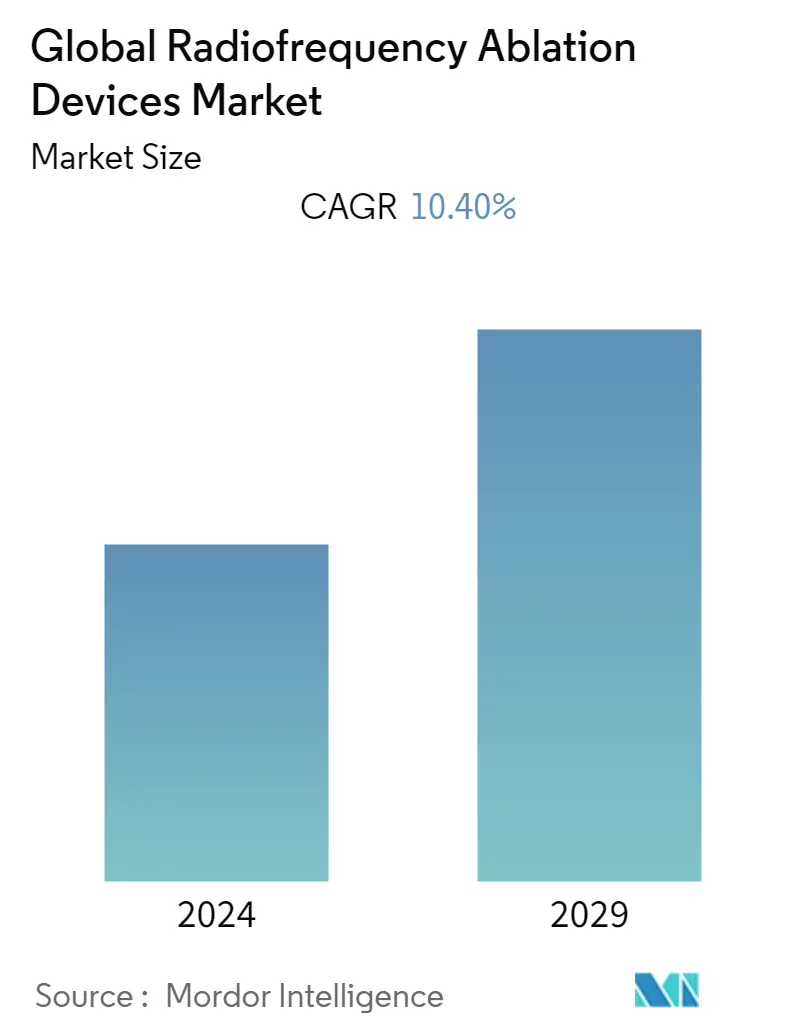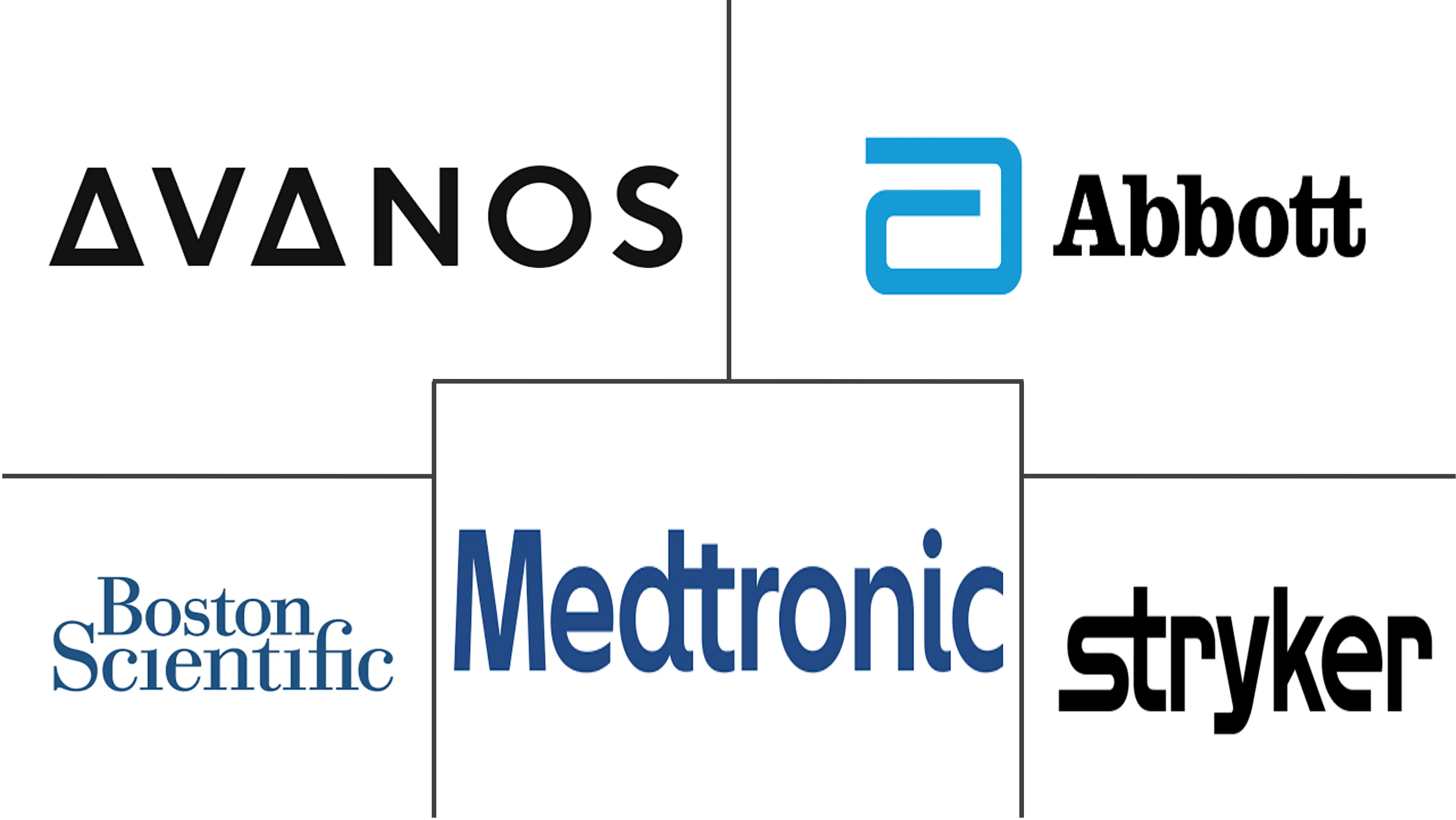Market Size of Global Radiofrequency Ablation Devices Industry

| Study Period | 2019 - 2029 |
| Base Year For Estimation | 2023 |
| Forecast Data Period | 2024 - 2029 |
| CAGR | 10.40 % |
| Fastest Growing Market | Asia-Pacific |
| Largest Market | North America |
Major Players
*Disclaimer: Major Players sorted in no particular order |
Radiofrequency Ablation Devices Market Analysis
The Radiofrequency Ablation Devices market is expected to grow at a significant CAGR of 10.4% during the study period, 2022-2027.
The COVID-19 pandemic affected healthcare systems globally and resulted in the interruption of usual care in many healthcare facilities, exposing vulnerable patients with cancer to significant risks. For instance, a study titled "Impact of the COVID-19 Pandemic on Cancer Care: A Global Collaborative Study" published in 2020 reported that there were several challenges in delivering cancer care based on a survey of a total of 356 centers from 54 countries across six continents that participated between April 21 and May 8, 2020. These centers serve 716,979 new patients with cancer every year. Most of them (88.2%) reported facing challenges in delivering care during the pandemic. Although 55.34% of the centers reduced their services as part of a preemptive strategy, other common reasons included an overwhelmed system (19.94%), lack of personal protective equipment (19.10%), staff shortage (17.98%), and restricted access to medications (9.83%). Moreover, catheter ablation procedures for atrial fibrillation (AF) were significantly curtailed during the peak of the COVID-19 pandemic to conserve healthcare resources and limit exposure. According to the study "Rebooting atrial fibrillation ablation in the COVID-19 pandemic," published in February 2021, there were no cases of ablation-related COVID-19 transmission in the study population. However, there were a smaller number of transesophageal echocardiography procedures performed in 2020 as compared to 2019 despite a greater prevalence of persistent arrhythmia in 2020, indicating that healthcare resources were reutilized for COVID-19 care. As a result, fewer ablation procedures were performed, thereby negatively impacting the market. Thus, such circumstances greatly affected the market's growth rate throughout the initial pandemic phase. However, the market is anticipated to gain traction as several elective and cancer care procedures have resumed to pre-pandemic levels across the globe.
The factors propelling the studied market growth are the increasing prevalence of minimally invasive procedures, the growing burden of chronic diseases, and the senior population. For instance, as per the 2020 statistics by GLOBOCAN 2020, 19,292,789 people were diagnosed with cancer in 2020. According to the same source, the number of people with cancer is estimated to reach 30.2 million by 2040. Thus, increasing cancer prevalence indicates a rising need for effective minimally invasive surgical procedures for cancer, thereby driving the demand for radiofrequency ablation devices.
Additionally, strategic initiatives such as product launches, mergers, acquisitions, partnerships, and others will lead to lucrative market growth. For instance, in March 2022, Shijiazhuang Suin Instruments Co., Ltd. launched an RF signal generator, an instrument that's especially used to produce RF signals for carrier tests.
Furthermore, the rising research and development studies proving the efficacies of existing products in the market are expected to further contribute to the market's growth. For instance, the article "Next-generation catheter cuts AF ablation time," published in January 2022, evaluated the Biosense Webster's Qdot Micro catheter and demonstrated that it is a contact force-sensing radiofrequency ablation catheter with temperature-controlled ablation and 3D electroanatomical mapping integration. It incorporated advanced, high-energy ablation, improved temperature monitoring, optimized irrigation, and higher signal resolution, providing physicians with a simplified workflow that helps shorten procedure time. These advantages of radiofrequency ablation devices are expected to increase their adaptability, thereby driving the market growth. Moreover, in February 2022, Ramesh hospitals launched a modernized cardiac electrophysiology lab in Vijayawada, India, which will incorporate new therapies such as radio frequency ablation, pacemakers, automatic implantable cardiac defibrillators, and others. Thus, such initiatives will increase the demand for radio frequency devices, thereby driving the market growth.
Therefore, owing to the factors above, the studied market is expected to grow significantly during the study period. However, low awareness and availability of alternative treatment methods and high treatment costs are expected to hinder the market's growth during the forecast period.
Radiofrequency Ablation Devices Industry Segmentation
As per the scope of the report, radiofrequency ablation is a medical procedure in which part of the electrical conduction system of the heart, tumor, or other dysfunctional tissue is ablated using the heat generated from medium-frequency alternating current. The devices used for these procedures are known as radiofrequency ablation devices. The Radiofrequency Ablation Devices Market is Segmented by Product Type (Radiofrequency Generators and Consumables), Application (Oncology, Cardiology and Cardiac Rhythm Management, Gynecology, Pain Management, and Other Applications), and Geography (North America, Europe, Asia Pacific, Middle East and Africa, and South America). The market report also covers the estimated market sizes and trends for 17 countries across major global regions. The report offers the value (in USD million) for the above segments.
| By Product Type | |
| Radiofrequency Generators | |
| Consumables |
| By Application | |
| Oncology | |
| Cardiology and Cardiac Rhythm Management | |
| Gynecology | |
| Pain Management | |
| Other Applications |
| Geography | ||||||||
| ||||||||
| ||||||||
| ||||||||
| ||||||||
|
Global Radiofrequency Ablation Devices Market Size Summary
The radiofrequency ablation devices market is poised for substantial growth, driven by the increasing prevalence of chronic diseases and the rising demand for minimally invasive procedures. The market's expansion is further supported by strategic initiatives such as product launches, mergers, and partnerships, which are enhancing the availability and efficacy of these devices. The oncology segment, in particular, is experiencing significant growth due to the rising number of cancer cases globally, necessitating effective surgical therapies. The market's recovery post-COVID-19, with the resumption of elective and cancer care procedures, is expected to contribute to its robust growth trajectory.
In North America, the market is bolstered by the high prevalence of chronic diseases and cancer, alongside strategic product introductions and regulatory approvals. Key players like Medtronic and Abbott are expanding their offerings with innovative devices aimed at treating conditions such as atrial fibrillation and managing pain through non-surgical methods. The competitive landscape is marked by the presence of major companies, including Avanos Medical Inc., Stryker, and Boston Scientific Corporation, which are driving market dynamics through continuous innovation and strategic collaborations. Despite challenges such as high treatment costs and limited awareness, the market is anticipated to grow significantly, supported by ongoing research and development efforts.
Global Radiofrequency Ablation Devices Market Size - Table of Contents
-
1. MARKET DYNAMICS
-
1.1 Market Overview
-
1.2 Market Drivers
-
1.2.1 Increasing Preference for Minimally Invasive Procedures
-
1.2.2 Increasing Prevalence of Chronic Diseases
-
-
1.3 Market Restraints
-
1.3.1 Low awareness and availability of alternative treatment method
-
1.3.2 High treatment cost
-
-
1.4 Porter's Five Forces Analysis
-
1.4.1 Threat of New Entrants
-
1.4.2 Bargaining Power of Buyers/Consumers
-
1.4.3 Bargaining Power of Suppliers
-
1.4.4 Threat of Substitute Products
-
1.4.5 Intensity of Competitive Rivalry
-
-
-
2. MARKET SEGMENTATION (Market Size by Value - USD Million)
-
2.1 By Product Type
-
2.1.1 Radiofrequency Generators
-
2.1.2 Consumables
-
-
2.2 By Application
-
2.2.1 Oncology
-
2.2.2 Cardiology and Cardiac Rhythm Management
-
2.2.3 Gynecology
-
2.2.4 Pain Management
-
2.2.5 Other Applications
-
-
2.3 Geography
-
2.3.1 North America
-
2.3.1.1 United States
-
2.3.1.2 Canada
-
2.3.1.3 Mexico
-
-
2.3.2 Europe
-
2.3.2.1 Germany
-
2.3.2.2 United Kingdom
-
2.3.2.3 France
-
2.3.2.4 Italy
-
2.3.2.5 Spain
-
2.3.2.6 Rest of Europe
-
-
2.3.3 Asia-Pacific
-
2.3.3.1 China
-
2.3.3.2 Japan
-
2.3.3.3 India
-
2.3.3.4 Australia
-
2.3.3.5 South Korea
-
2.3.3.6 Rest of Asia-Pacific
-
-
2.3.4 Middle-East and Africa
-
2.3.4.1 GCC
-
2.3.4.2 South Africa
-
2.3.4.3 Rest of Middle-East and Africa
-
-
2.3.5 South America
-
2.3.5.1 Brazil
-
2.3.5.2 Argentina
-
2.3.5.3 Rest of South America
-
-
-
Global Radiofrequency Ablation Devices Market Size FAQs
What is the current Global Radiofrequency Ablation Devices Market size?
The Global Radiofrequency Ablation Devices Market is projected to register a CAGR of 10.40% during the forecast period (2024-2029)
Who are the key players in Global Radiofrequency Ablation Devices Market?
Avanos Medical, Inc., Stryker , Abbott, Medtronic and Boston Scientific Corporation are the major companies operating in the Global Radiofrequency Ablation Devices Market.

